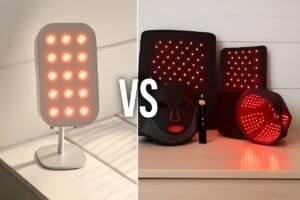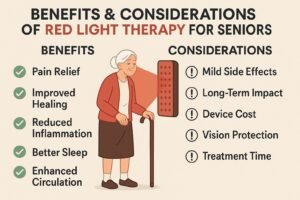Expert Interview: Insights into Red Light Therapy from a Clinical Specialist
Key Points
- Red light therapy in a clinical setting uses specific wavelengths (630-660nm and 810-850nm) to stimulate cellular function and increase ATP production in the mitochondria
- Research indicates significant benefits for skin rejuvenation, hair growth, inflammation reduction, and pain management when administered properly in a clinical setting
- Home devices typically deliver less power than clinical-grade equipment, requiring longer or more frequent sessions for similar results
- Not all conditions respond equally to red light therapy; skin and hair applications have the strongest scientific evidence
- Consulting with a healthcare provider before starting red light therapy is essential, especially for those with photosensitivity or taking certain medications
Red light therapy has moved from obscure medical applications to become a mainstream treatment option in both clinical settings and at home. But with its growing popularity comes confusion about what it actually does and how it works. I recently had the chance to interview Dr. Rachel Martinez, a dermatologist who specializes in photobiomodulation therapies, to get some clarity on this increasingly popular treatment.
“The critical thing to remember about clinical red light therapy is that it’s not some mystical process—it’s grounded in science,” says Dr. Martinez. “We’re utilizing distinct wavelengths of light that engage with the body at a cellular level in ways that are both foreseeable and quantifiable.” This level of accuracy is what distinguishes genuine clinical uses from the dubious marketing assertions that have started to muddy the waters of the industry.
Understanding Red Light Therapy from a Clinical Point of View
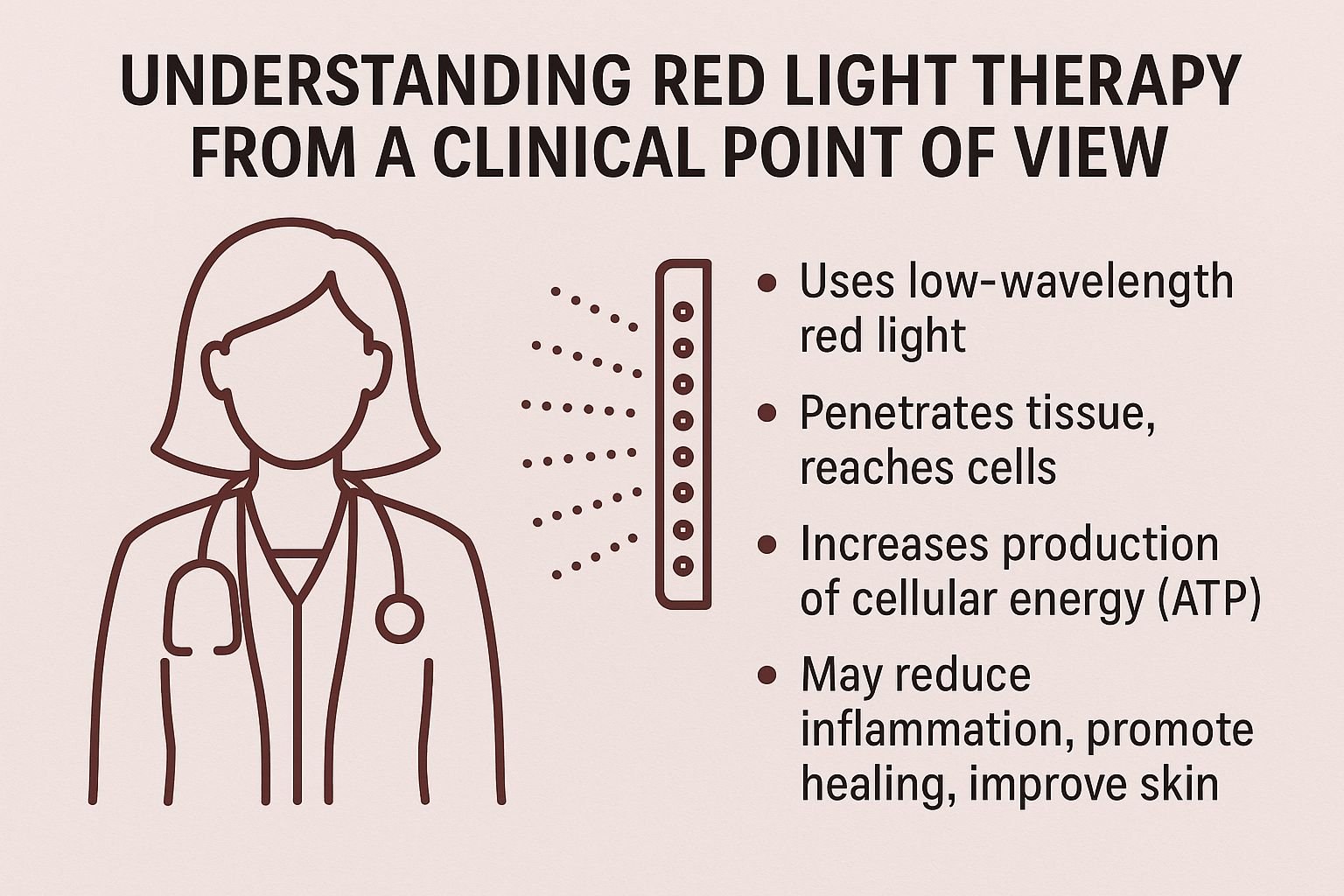
Red light therapy, also known as low-level laser therapy or photobiomodulation, is not just another wellness fad. It has a solid scientific foundation that dates back to the 1960s. The therapy was born when NASA researchers found that certain red light wavelengths promoted plant growth and healing in space. This finding prompted further studies into its effects on human tissue, leading to FDA-approved devices for various medical uses.
“The key difference between red light therapy and other light-based treatments is that it doesn’t harm tissue to promote healing,” says Dr. Martinez. “While treatments like laser resurfacing or intense pulsed light treatments cause controlled damage to trigger the body’s repair response, red light therapy directly stimulates cellular function without causing harm.” This non-invasive nature makes it an attractive option for those seeking gentler treatment options.
Red light therapy is now used in a variety of medical fields, including dermatology, physical therapy, sports medicine, and pain management. Depending on the treatment goal, the therapy is administered through panels, wands, beds, or targeted devices that emit red and/or near-infrared light at specific intensities and wavelengths.
What Red Light Therapy Really Does to Your Body
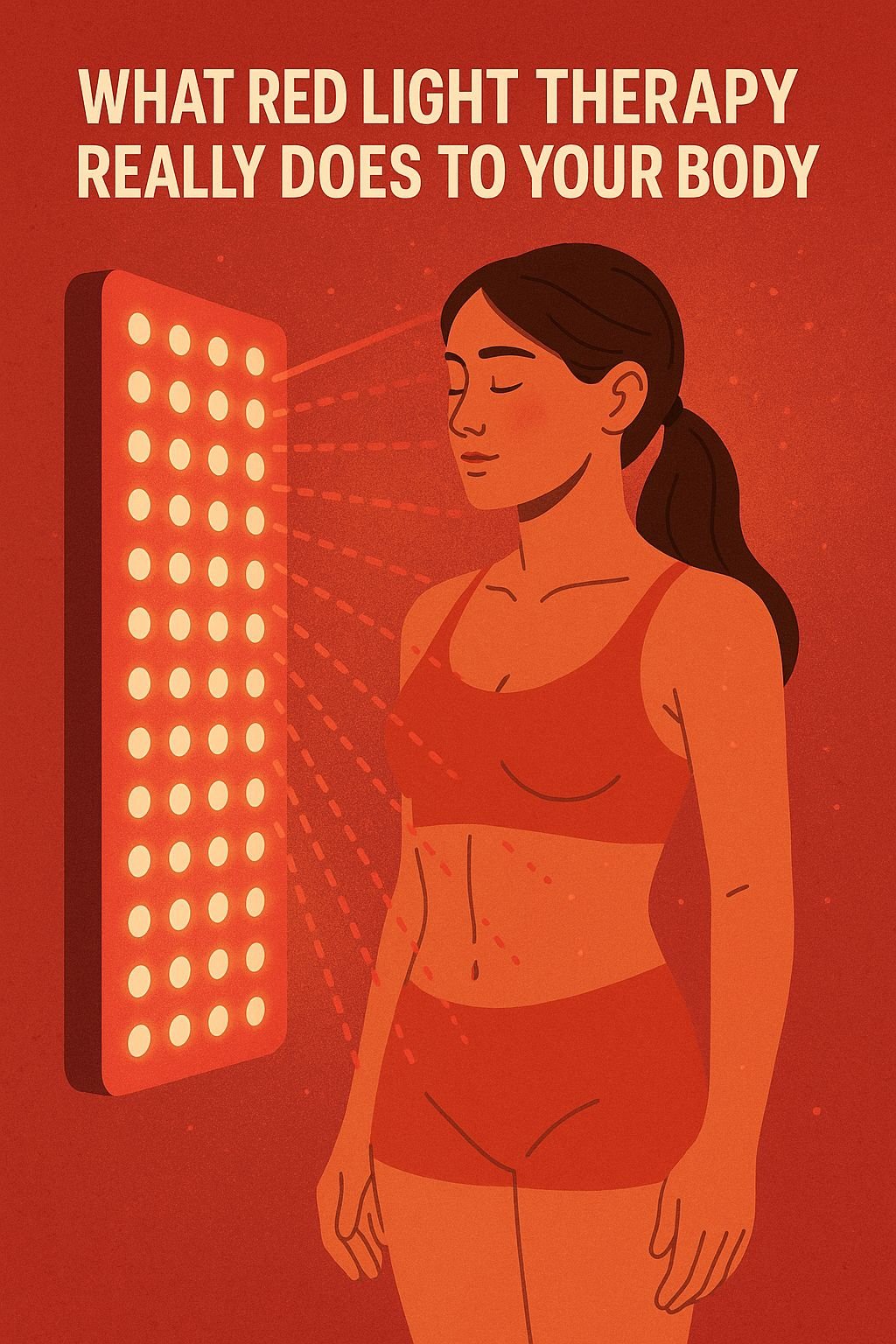
Grasping how red light impacts the body involves a quick trip into the world of cellular biology. When I requested Dr. Martinez to break down the process in layman’s terms, she gave an impressively straightforward description of a complicated procedure. For more insights, you can explore red light therapy at medical clinics.
How Red Light Therapy Works at the Cellular Level
“The way red light therapy works is through a process known as photobiomodulation,” says Dr. Martinez. “What happens is that certain wavelengths of red light penetrate the skin and get absorbed by a photoreceptor in our cells called cytochrome c oxidase, which is part of the mitochondrial respiratory chain.” This interaction sets off a series of cellular events that result in increased energy production, reduced oxidative stress, and improved cell signaling—all of which help repair and regenerate tissue.
Cellular stimulation isn’t limited to one type of cell, it impacts a variety of cell types throughout the body. Fibroblasts generate more collagen, macrophages increase their removal of cellular debris, and nerve cells can transmit signals more effectively. “This overall enhancement in cellular function is what makes red light therapy so adaptable,” Dr. Martinez elaborates.
Why 630-660nm and 810-850nm Wavelengths Are Most Effective
Dr. Martinez stresses that not all red light is therapeutic. “The wavelength of light used is absolutely critical,” he says. “The most effective ranges are 630-660 nanometers for red light and 810-850 nanometers for near-infrared light.” These specific wavelengths have been identified through extensive research as the most bioactive, with the ability to penetrate tissue at optimal depths.
Red light that falls within the 630-660nm range can penetrate tissue to a depth of about 8-10mm. This makes it a great option for addressing surface issues such as skin texture, fine lines, and superficial wounds. Near-infrared light in the 810-850nm range can penetrate much deeper, up to several centimeters. This allows it to affect deeper tissues like muscles, joints, and even bones. Clinical devices are calibrated to deliver precise wavelengths at therapeutic intensities. This is why they typically produce more dramatic results than consumer-grade products.
Boosting Mitochondria and ATP Production
Red light therapy’s effectiveness is grounded in how it affects mitochondria, the power generators of our cells. “Mitochondria absorb red light, which increases the production of adenosine triphosphate or ATP, basically our cellular energy,” says Dr. Martinez. “When there’s more ATP, cells have more resources to function at their best and repair themselves when necessary.” This increase in cellular energy production is especially helpful in tissues that are damaged or stressed.
Studies have demonstrated that ideal exposure to red light can boost ATP production by 200% in certain types of cells. This increase in energy not only enables cells to carry out their specific functions more efficiently, but it also strengthens their ability to withstand stress. For tissues that are aging or damaged, this could mean noticeable enhancements in how they look and work that may not be possible with other non-invasive treatments.
Red Light Therapy Benefits Backed by Research
Scientific evidence for red light therapy has significantly increased in recent years. Dr. Martinez says, “We now have hundreds of peer-reviewed studies demonstrating efficacy for certain conditions. However, the quality of evidence greatly differs depending on the application.” Knowing where the most substantial evidence is can help both clinicians and patients establish practical expectations.
Revitalizing Skin and Boosting Collagen
One of the most well-known benefits of red light therapy is its ability to rejuvenate the skin. “We have substantial clinical data that shows consistent red light treatments increase collagen and elastin, reduce wrinkles, and improve the skin’s overall appearance,” Dr. Martinez shares. A study from 2014 published in Photomedicine and Laser Surgery showed that subjects who received red light therapy twice a week for 30 sessions saw a significant improvement in their skin’s complexion, texture, and collagen density, as measured by an ultrasound.
Red light’s revitalizing effects come from its ability to activate fibroblasts, which are the cells that produce collagen, while also boosting blood flow to the skin. This two-pronged approach not only helps restore the skin’s supportive structure, but it also improves the delivery of nutrients and the removal of waste. For mature skin, this means a younger look without the recovery time that comes with more intense treatments.
Potential and Limitations for Hair Regrowth
Red light therapy is becoming popular for hair restoration, especially for androgenetic alopecia (pattern baldness). “The research is quite compelling for hair growth,” says Dr. Martinez. “We see increased hair density, thickness, and growth rate in patients who use clinical-grade red light consistently.” FDA-cleared devices specifically for hair loss typically utilize wavelengths between 630-670nm, delivered through helmets, caps, or combs designed to target the scalp.
Lessening Inflammation and Speeding up Healing
One of the most beneficial clinical uses of red light therapy is its ability to reduce inflammation. Research has found that certain wavelengths can decrease inflammatory markers and speed up the repair of tissue. “We frequently suggest red light therapy for patients who are recovering from procedures or injuries, as it noticeably shortens the healing time and lessens pain,” states Dr. Martinez. The therapy accomplishes this by adjusting cytokine production, lessening oxidative stress, and encouraging more effective cellular repair mechanisms—all of which are vital parts of the healing process.
Using Red Light Therapy for Pain Relief
Red light therapy is a non-drug treatment option for chronic pain with almost no side effects. Studies in The Lancet and Pain Medicine have found significant pain relief in everything from osteoarthritis to fibromyalgia. Dr. Martinez explains, “The thing that makes red light so useful for pain relief is that it treats the inflammation that’s causing the pain, rather than just hiding the symptoms. Many of my patients have been able to cut back on their pain medication after they started regular red light treatments.”
Debunking Common Myths About Red Light Therapy
Even with a plethora of research supporting its benefits, red light therapy continues to be a subject of confusion for many. Dr. Martinez devotes a significant portion of his time to educating his patients about the realities of this treatment, distinguishing between what’s true and what’s not.
Red Light Therapy Isn’t a Panacea
“A common misunderstanding I come across is that red light therapy is a panacea,” Dr. Martinez says, sounding weary. “While it can be used for many things, there are definite limits to its effectiveness.” She stresses that the conditions with the most robust evidence base are skin rejuvenation, hair loss, wound healing, and certain types of pain management. Claims about weight loss, depression treatment, or cancer therapy have much less scientific backing and should be approached with caution.
Dr. Martinez also addresses another common misunderstanding about treatment timelines. “Patients often expect instant results, but photobiomodulation is a process that builds up over time,” she explains. “Most people need at least 8-12 consistent sessions before they notice significant improvements, and they usually need to continue the treatment to maintain the results.”
Understanding the Difference Between Home and Clinical Devices
With the increase in consumer red light devices, there are many misconceptions about their effectiveness in comparison to clinical treatments. Dr. Martinez explains, “The main differences are power output, treatment area coverage, and precision of wavelength delivery.” Although high-quality home devices can definitely be useful, they usually deliver less power (measured in mW/cm²) than clinical equipment, which means longer or more frequent sessions may be required to achieve similar results. Many clinics use professional-grade panels that deliver 100-150 mW/cm² of power, while consumer devices might only deliver 20-50 mW/cm².
More Isn’t Always Better
Dr. Martinez cautions that more red light therapy isn’t always better. “Our bodies respond to red light therapy in a biphasic dose-response curve. This means that benefits increase up to a certain point, then plateau or even decline with excessive exposure.” So, daily treatments might not be more effective than treatments 3-4 times weekly, and longer sessions don’t necessarily produce better outcomes than the clinically recommended duration.
That’s why some people notice that their results level off or even decrease after they start to see improvements. If you follow the recommended guidelines, which usually involve using the device for 10 to 20 minutes at the right distance, three to five times a week, you’re likely to get the best results. For those interested in understanding more about how this technology works, here’s a guide for beginners on near-infrared sauna technology. This way, you won’t waste your time or risk getting too much exposure.
Red Light Therapy in Clinical Practice: When and Why Doctors Prescribe It
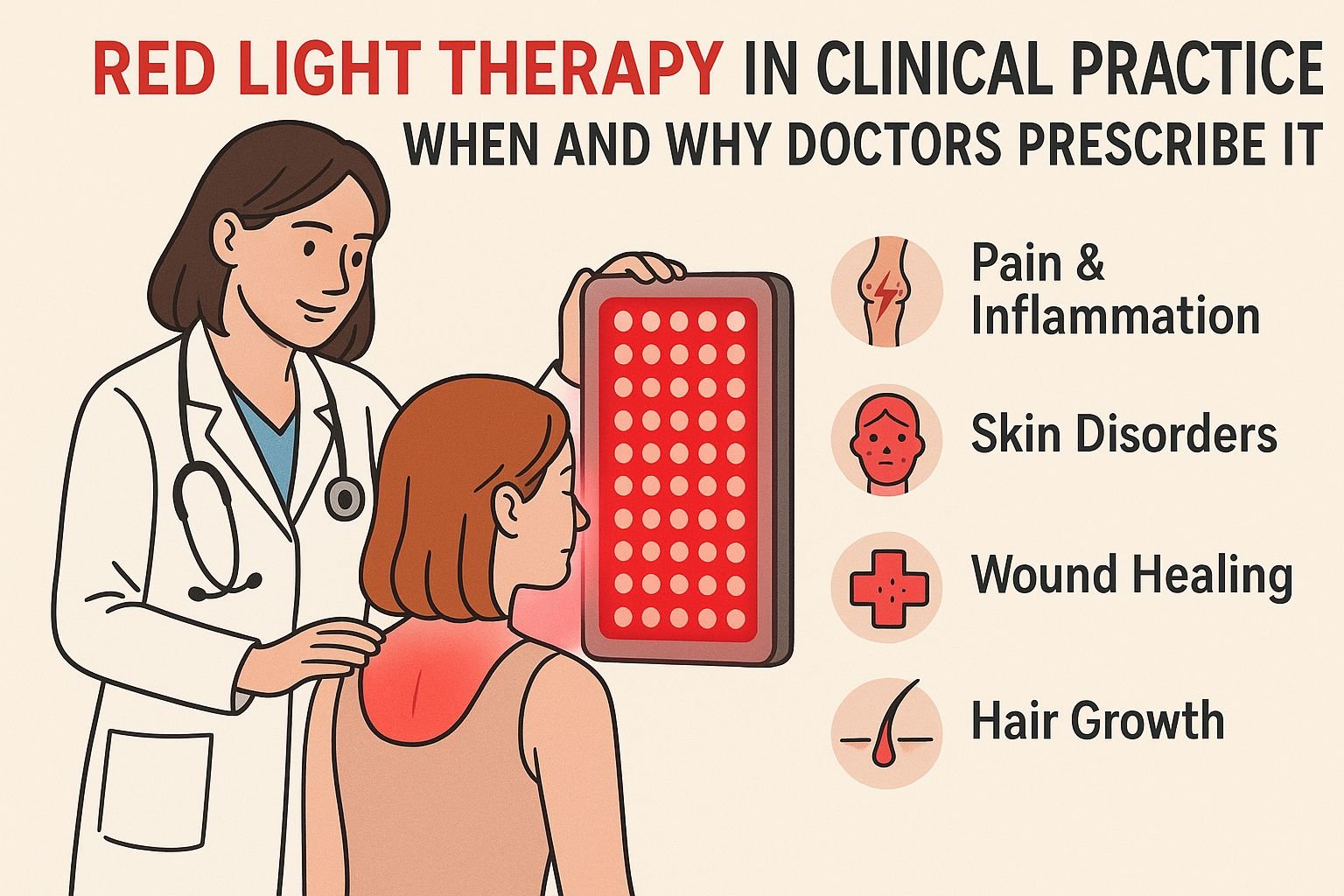
Red light therapy has slowly but surely become a part of treatment plans for certain conditions where there is evidence of its effectiveness. Dr. Martinez notes, “We are seeing red light therapy being prescribed more and more often in clinical practice, especially in the fields of dermatology, physical rehabilitation, and sports medicine.” Knowing when and why doctors recommend this therapy helps to understand its real-world uses.
Doctors are typically wary of new treatments, so it’s significant that red light therapy is gaining traction. “What’s changed in recent years is the quality of the research,” Dr. Martinez says. “We now have randomized controlled trials and systematic reviews that meet rigorous scientific standards, which makes doctors more comfortable recommending these treatments.”
Red Light Therapy: A Dermatologist’s Perspective
Dr. Martinez, a clinical specialist, reveals that dermatology is the field with the most evidence supporting red light therapy. He frequently recommends it for common skin conditions such as psoriasis, eczema, rosacea, and acne. “These inflammatory skin conditions respond particularly well to the anti-inflammatory effects of specific red light wavelengths,” he explains. Dr. Martinez notes that some dermatology clinics even combine red light with blue light (known for its antimicrobial properties) to treat conditions like acne. These clinics develop personalized treatment plans based on each patient’s unique skin needs.
Photodynamic therapy, a treatment that combines red light with photosensitizing agents, is now a common treatment for some precancerous skin conditions and superficial skin cancers. “This is one of the most medically validated applications,” says Dr. Martinez. “The photosensitizer selectively accumulates in abnormal cells, and when activated by red light, triggers controlled destruction of those cells while sparing healthy tissue.”
Improving Recovery After Surgery
Red light therapy is becoming a popular recommendation by surgeons and wound care specialists to speed up the healing process after surgery. “The evidence supporting wound healing is quite robust,” says Dr. Martinez. “We’ve seen quicker epithelialization, less scarring, and fewer infections when red light is used during the recovery phase.” This treatment has become especially useful in the field of plastic surgery, where the main goals are to heal as best as possible and leave as little scarring as possible.” Read more about red light therapy and its applications in medical clinics.
In 2018, a comprehensive study was published in the Journal of Photochemistry and Photobiology that analyzed 22 studies on red light therapy and its effects on wound healing. The results were overwhelmingly positive, showing significant reductions in wound size, pain levels, and healing time. It was also found that these benefits were consistent across a variety of wound types, from surgical incisions to chronic diabetic ulcers, although the best protocols varied depending on the specific characteristics of the wound.
Aiding Chronic Conditions
Red light therapy is being recommended more and more as an additional treatment for patients with chronic conditions that involve ongoing inflammation or pain. “We’ve seen especially good results with conditions like fibromyalgia, rheumatoid arthritis, and neuropathic pain conditions,” Dr. Martinez shares. “While it’s usually not the only treatment for these complicated conditions, it can greatly decrease pain and enhance quality of life when it’s part of an all-inclusive treatment plan.”
What’s so great about red light therapy for managing chronic diseases is how safe it is. While drugs can cause side effects if used for a long time, red light therapy can be used for as long as you need it with very little risk. That makes it a great choice for diseases that need to be managed over a long period of time. Some pain management doctors now offer red light therapy as part of a treatment plan that tries to reduce the need for medication.
Applications in Athletic Recovery
Red light therapy has been widely accepted in the sports medicine community for both injury recovery and performance enhancement. “Elite athletes were some of the first to adopt this technology,” says Dr. Martinez. “They use it to decrease muscle soreness, speed up recovery post-training, and treat specific injuries.” Research has shown decreased recovery time and reduced inflammatory markers in athletes who use red light therapy after rigorous exercise.
Red light therapy has become a staple in the recovery protocols of many professional sports teams and Olympic training facilities. It has been shown to reduce delayed onset muscle soreness (DOMS) and speed up the recovery process for soft tissue injuries like sprains and strains. The therapy achieves these results through several means, including increasing microcirculation to damaged tissues, reducing oxidative stress, and modulating inflammatory responses. For those new to this therapy, exploring a guide for beginners can provide valuable insights into its benefits.
Picking the Perfect Red Light Therapy Device
The sheer volume of devices available can make choosing the right one a daunting task. There are hundreds of options, from $30 handheld devices to $10,000 professional systems. Dr. Martinez offers some useful advice for both clinicians and consumers trying to decide between them.
What Sets Medical-Grade Devices Apart
Healthcare facilities often use high-output LED panels or laser systems that are specifically designed for medical uses. Dr. Martinez explains, “Clinical-grade devices are set apart by their precise wavelength delivery, high irradiance (power density), the ability to cover large treatment areas, and durability for ongoing use.” These devices usually let practitioners choose specific wavelength combinations and treatment parameters based on the condition they’re treating.
Devices used in medicine are subject to more stringent testing and certification than those available to the public. Dr. Martinez recommends checking for FDA clearance for specific uses and third-party verification of output specifications. He cautions that many manufacturers make claims about power output that are not supported by independent testing. Clinical devices usually deliver irradiance levels between 100-150 mW/cm² at the recommended treatment distance. This allows for shorter, more effective treatment sessions. For a deeper understanding of the benefits, you can explore chromotherapy lighting benefits in related technologies.
Choosing the Right At-Home Device
If you’re thinking about using red light therapy at home, Dr. Martinez suggests you pay attention to a few key things: “First, make sure the device provides the correct wavelengths—usually 630-660nm for red light or 810-850nm for near-infrared. Second, look at the irradiance at the suggested treatment distance; good home devices should provide at least 20-30 mW/cm². Third, think about the treatment area—small handheld devices are good for spot treatments but not practical for larger areas like the back or multiple treatment zones.”
Watch out for very cheap options that make exaggerated promises. “A lot of budget devices just don’t deliver enough power or the right wavelengths to achieve clinical effects,” warns Dr. Martinez. “I usually advise patients to look for transparent manufacturers who provide detailed specifications and ideally, published research supporting their specific device.” For a comparison of different devices, you might find this analysis review helpful.
Effective Treatment Plans
Red light therapy is most effective when it is consistently applied using evidence-based protocols. “The biggest mistake I see is people either using it inconsistently or stopping too early,” says Dr. Martinez. “Photobiomodulation requires a cumulative effect to create lasting changes in tissue.” Research-supported protocols generally involve treatments 3-5 times a week for 4-12 weeks, followed by maintenance sessions 1-2 times a week once the desired results have been achieved.
According to Dr. Martinez, the distance from the light source can significantly impact the power delivered to the tissue. “Most devices have a specific recommended treatment distance—usually 6-12 inches—and moving closer doesn’t necessarily increase effectiveness,” he says. “In fact, being too close can actually reduce penetration due to heat buildup in surface tissues.” It’s important to follow the manufacturer’s guidelines for distance and treatment duration to ensure safety and effectiveness.
Be Wary of Marketing Promises
The market for red light therapy devices has grown rapidly, with many devices making more and more extravagant promises. “Be very suspicious of devices that claim to treat serious medical conditions like cancer, diabetes, or Alzheimer’s disease,” Dr. Martinez advises. “These promises aren’t backed up by enough evidence and often prey on people who are vulnerable.” Also, be careful of marketing that promises instant or dramatic results, as the biological processes that red light therapy stimulates usually take time to produce noticeable changes.
Dr. Martinez also points out that a lack of technical information is a red flag. “Reputable manufacturers will readily provide details about wavelengths, power output at specific distances, and treatment area coverage,” he says. “If this information isn’t available or the company refuses to provide it when asked, that’s a red flag.” Reputable companies typically invest in research and provide education about appropriate use rather than relying solely on testimonials and before/after photos.
The Role of Red Light Therapy in Future Medicine
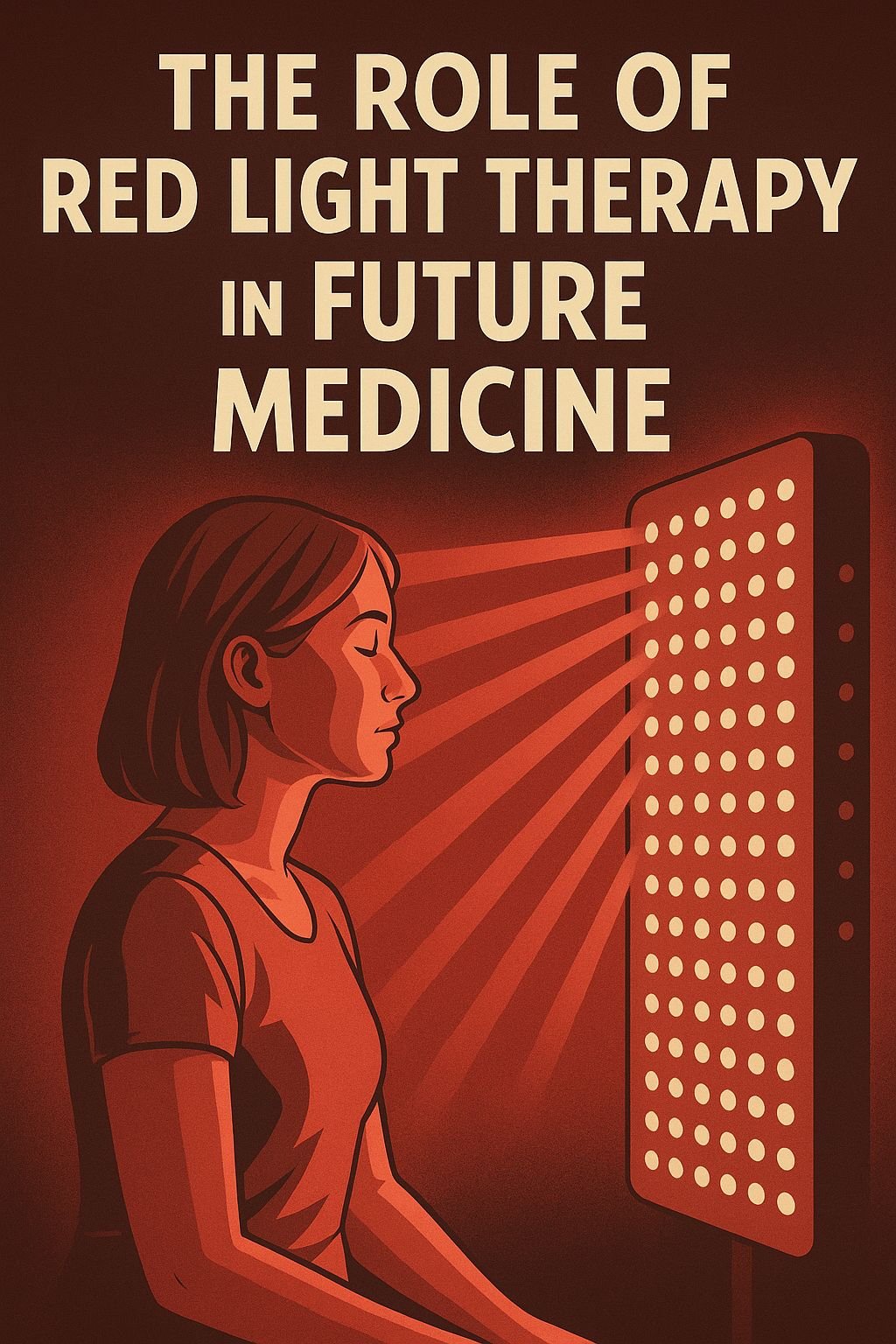
With the ongoing research, it is expected that red light therapy will be more widely accepted in the medical field. “We are only beginning to learn how light interacts with our biological systems,” says Dr. Martinez. “As we learn more, we can expect more specific protocols and more uses in the next ten years.”
It seems that we’re headed towards a more personalized approach, taking into account each individual’s biology and specific conditions. “We’re discovering that aspects such as age, skin type, tissue composition, and even genetic variables can affect how one responds to photobiomodulation,” says Dr. Martinez. “It’s likely that future treatments will be customized to these individual factors instead of using a one-size-fits-all approach.”
New Fields of Study
There are many new and exciting areas of research that are broadening our knowledge of the potential of red light therapy. “The neurological applications that are currently being studied are of particular interest to me,” says Dr. Martinez. “The preliminary research on red light therapy for traumatic brain injury, stroke recovery, and neurodegenerative diseases is showing some fascinating results.” These applications use near-infrared wavelengths that can penetrate the skull and potentially modulate neuroinflammation and cellular energy production in brain tissue.
Combination Therapies Show Potential
Red light therapy is likely to be combined with other treatment methods in the future. “We’re seeing incredible synergy when red light is combined with specific topical products, supplements, or other energy-based treatments,” says Dr. Martinez. For instance, combining red light with hyaluronic acid serums seems to improve hydration and plumping effects, while using it after microneedling can speed up healing and improve collagen induction.
A few of the most exciting combined methods being studied right now are:
- Red light with peptide-based serums for enhanced skin firming
- Combined red and blue light protocols for inflammatory acne
- Red light with specific exercise protocols for enhanced muscle recovery
- Photodynamic therapy with new sensitizing agents for targeted treatment
- Near-infrared light with cognitive training for brain health applications
“These combination approaches represent the cutting edge of research,” explains Dr. Martinez. “By understanding how red light interacts with other interventions, we can develop more effective protocols that address multiple aspects of a condition simultaneously.”
Making Red Light Therapy a Standard Part of Medicine
Red light therapy has been slowly gaining acceptance in the medical community, with more insurance companies covering it for some uses and more medical schools teaching photobiomodulation. “There’s a change in the way people are thinking about therapies that use light,” says Dr. Martinez. “What used to be thought of as alternative or experimental is now seen as a real medical treatment that has a lot of scientific evidence to support it.”
There are hurdles to overcome, especially when it comes to the standardization of protocols and quality control of devices. “To get red light therapy fully integrated into conventional medicine, we need to standardize treatment parameters and have more consistent manufacturing standards,” says Dr. Martinez. A number of medical organizations are working to set treatment guidelines and device standards that will make it easier to adopt more widely.
“The most exciting aspect of red light therapy’s future is its potential to provide effective treatment without side effects. As we face challenges with antimicrobial resistance and medication side effects, therapies that work with the body’s natural processes rather than against them will become increasingly valuable in medicine.” – Dr. Rachel Martinez
With hundreds of clinical trials currently underway investigating new applications for red light therapy, the evidence base continues to expand rapidly. Medical innovations often move from fringe to mainstream when sufficient research accumulates, and red light therapy appears to be following this trajectory.
Expert Tips for Beginners
If you’re thinking about trying red light therapy, Dr. Martinez has some practical advice: “First, figure out what you want to achieve and then research whether there’s strong evidence that red light can help with that. If you have any health issues, talk to a healthcare provider who knows about photobiomodulation. You might want to try professional treatments before you buy a home device. That way, you can see if the therapy works for you. The most important thing to remember is that red light therapy isn’t a miracle cure. It works best as part of a bigger health plan that includes other treatments that are proven to work for your condition.”
Commonly Asked Questions
During our conversation, Dr. Martinez answered a number of questions that patients often have about red light therapy. These useful tips can help set expectations and guide the correct use of this increasingly popular treatment method.
“Education is key when it comes to red light therapy. When patients understand how it works, what to expect, and how long it takes, they’re more likely to use it correctly and see good results.” – Dr. Rachel Martinez
Here are the most common questions Dr. Martinez gets asked in her practice, along with her evidence-based answers:
How quickly will I see results from red light therapy?
According to Dr. Martinez, the timeline for results can vary widely based on the condition being treated and individual factors. “For skin issues like fine lines or texture, most patients see improvements after 4-6 weeks of consistent treatment. Hair growth usually takes longer, with initial results visible around 8-12 weeks. Pain and inflammation can sometimes respond more quickly, often within just a few sessions, but the effects are often temporary at first and become more lasting with continued treatment.”
- Skin rejuvenation: Visible changes in 4-6 weeks
- Hair growth: Initial results in 8-12 weeks
- Wound healing: Accelerated healing noticeable within days
- Pain management: Some relief often within 24-48 hours, lasting effects after 2-3 weeks
- Muscle recovery: Reduced soreness within 24-72 hours after exercise
“Patience and consistency are absolutely essential,” emphasizes Dr. Martinez. “Photobiomodulation works by stimulating natural cellular processes, which simply take time to create visible or measurable changes in tissue.”
Can anyone use red light therapy?
Red light therapy is known for being a safe treatment for all kinds of skin types. Dr. Martinez says, “Red light therapy doesn’t cause hyperpigmentation in darker skin tones like other light-based treatments do. It doesn’t rely on thermal damage or target melanin, so it’s unlikely to cause changes in pigmentation.” This makes red light therapy one of the few light-based treatments that work for all skin tones. However, people with certain photosensitizing conditions or medications should talk to their healthcare provider before starting treatment.
Is red light therapy effective for weight loss?
While some marketers may claim otherwise, the evidence supporting red light therapy as a weight loss tool is still sparse. “There are some early studies that suggest red light may affect the function of fat cells, but the research is still in its infancy and the results have been, at best, modest,” warns Dr. Martinez. “The most convincing data we have is related to body contouring rather than actual weight loss, and even these effects need to be combined with other interventions such as exercise.”
Dr. Martinez advises caution with devices marketed primarily for weight loss: “The misleading marketing in this area is a particular concern of mine. Although red light therapy has many valid uses, significant weight loss is not currently one of them according to the evidence we have.” Those looking for weight management solutions should concentrate on proven methods such as nutrition and physical activity, and only consider red light therapy as a possible supplementary approach for related issues such as muscle recovery.
What is the recommended frequency for red light therapy to achieve the best results?
How often you should use red light therapy will depend on the specific condition you’re treating and the type of device you’re using. “For most uses, the ideal frequency seems to be between 3-5 times a week during the initial phase, which usually lasts anywhere from 4-12 weeks,” says Dr. Martinez. “Once you’ve achieved the results you want, maintenance sessions once or twice a week are generally enough to maintain those benefits.” It’s worth noting that clinical-grade devices, which have a higher power output, may not require as many sessions as home devices, which typically deliver less energy per treatment.
Dr. Martinez warns that overdoing it can actually decrease the effectiveness of the treatment due to the biphasic dose response characteristic of photobiomodulation. “With red light therapy, more isn’t always better,” he says. “Cells have regulatory mechanisms that can dampen response if stimulated too frequently. I’ve had patients who actually saw improved results when reducing from daily to every-other-day treatments.” It’s important to follow evidence-based protocols rather than assuming that the more exposure you get, the better the results will be.
Can red light therapy affect the medications I’m currently on?
Red light therapy doesn’t often directly interact with medications, but some medications can increase photosensitivity. “If you’re taking photosensitizing medications like tetracycline antibiotics, certain antipsychotics, or some heart medications, you should talk to your healthcare provider before starting red light therapy,” Dr. Martinez suggests. “These medications can make your skin more reactive to light energy, which could increase the risk of negative effects.” In the same way, topical retinoids and acids can increase skin sensitivity and might need to be temporarily discontinued before red light treatments.
Dr. Martinez pointed out that red light therapy can change how the body processes some medications and compounds applied to the skin. “We have seen increased absorption of topical products when they are used before or after red light therapy,” she said. “This can be a good thing when it’s done on purpose, but patients need to tell their provider about all the products they’re using so they don’t have any unexpected interactions.” This helps healthcare providers give the right advice about when to use products to get the most benefits and the least risks.
When understood and used correctly, red light therapy can be a beneficial addition to today’s health and wellness toolkit. Dr. Martinez reminds us that “It’s important to have realistic expectations, follow evidence-based protocols, and use it in conjunction with other appropriate treatments instead of seeing it as a cure-all.” By remembering these guidelines, patients can make educated choices about including red light therapy in their healthcare routine.
Get more in-depth information about clinical red light therapy and find qualified providers near you at our extensive guide to photobiomodulation therapies. Here, you’ll find protocols and practitioner resources based on research to help you get the most out of this innovative treatment approach.

